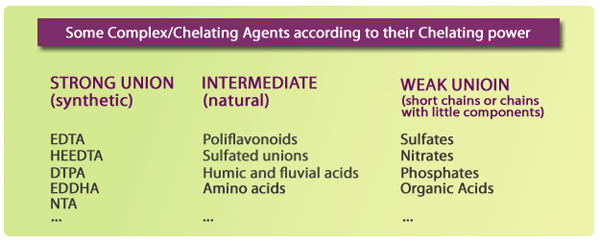Chelating Agent
How strong the union with the nutrient’s cations is what influences the availability of minerals for the plants
A chelating agent with weak bonds is not able to protect itself against hydrolysis, especially when the environmental pH level is high.
However, a chelate with considerable strength in its unions can bind the nutrient in such a way that it makes it difficult to release them to the plants.
Agents with strong complex power (i. e., synthetic chelates) are mostly used in soil applications. When the soil has elevated pH conditions (>7.8), the nutrient remains soluble thanks to the chelate’s elevated stability.
Despite the high efficacy of the synthetic chelates to prevent precipitation and/or insolubility of the nutrients, its biological efficacy value is low.
Other types of chelating agents are able to favour an increment in absorption of the complex formed with the nutrient. This is because they have not only chelating properties (although not as stable as that of the synthetic chelates); but also other biologically efficient properties.
In the latter type it has often been described that complexes of nutrients and amino acids, organic acids as well as other organic substances with low molecular weight, can be found not only in the soil’s solution but also in the interior of plants with biologically active properties.
In the case of amino acid based chelates, their biological power basically comes from the fact that when one such element is linked to one or to several amino acids, it can be transported thorough the cell’s membrane like a simple amino acid.
Moreover, it has been described that the route inside the cell of an element linked to amino acids goes directly to the sites of high metabolism, while elements being transported alone would accumulate in storage places, such as the vacuole as reserve for metabolic activity.

References
A. Wallace et al; 1982/Wittwer, S. H. et al; 1965 / Fisher, F.L.; 1984/ Stevenson F.J. et al, 1982 / Miller G.W. et al, 1983 / N.Reyes, 1982 / L. Fugua, 1982/ Römheld V. et, 1989/.